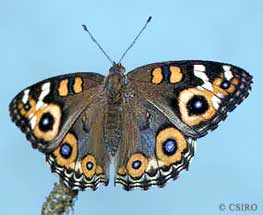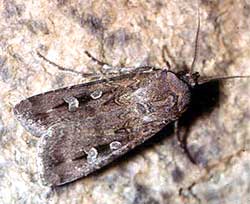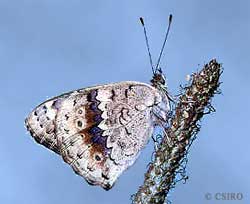|
Lepidoptera:
moths and butterflies
Characteristics
This is
one of the most well known and easily recognisable orders of insects
and contains about 21 000 species in Australia. Moths and butterflies
are grouped together in the order Lepidoptera, which means 'scaly
wings'. Below are the main characteristics of butterflies and moths.
|

Junonia villida calybe (meadow
argus butterfly)
|
|
- 2 pairs of
membranous
wings that are covered in tiny scales which overlap like shingles
on a roof. A few moths are wingless
- One ocelli
present above each eye
- Antennae
present. Antennae are long and slender in female moths and generally
feathery in male moths. Butterflies have clubbed antennae
- Mouthparts
are formed into a sucking tube known as a haustellum
The larvae
are typically known as caterpillars and have a sclerotised
head with chewing (mandibulate)
mouthparts, 3 pairs of thoracic
legs and often short, unsegmented prolegs
on the abdomen.
Is it
a moth or a butterfly? Put simply, butterflies are just
day-flying moths. Butterflies have clubbed antennae and the habit
of holding their wings vertically when at rest whereas moths sit
with their wings flat. Some day-flying moths are brightly coloured
and may be mistaken for butterflies.
Life Cycle
Moths
and butterflies undergo a complete
life cycle that includes four stages: egg, caterpillar
(larvae), pupae
and adult. The eggs are usually laid on or close to the caterpillar's
food plant either singularly or in groups. A female may lay only
a few eggs or tens of thousands depending on the species, but several
hundred is reasonably typical. After hatching caterpillars usually
develop through 4 to 7 instars
over a period of a few weeks up to a few months depending on the
species, before pupating.
When ready to pupate caterpillars generally find a sheltered site
to spin their cocoons.
Some may pupate attached to vegetation, others in the soil or leaf
litter or inside the wood they have been tunneling in. Many moths
and butterflies have one or two generations each year while others
may breed continuously. Other species such as the large wood-boring
Cossidae may take up to five years to develop.
Feeding
Most larvae
of moths and butterflies are herbivores
either eating foliage or wood, but some are carnivorous
cannibalising other caterpillars or feeding on soft bodied insects
such as scale or ant larvae. Adults are generally nectar feeders,
although a few have reduced mouthparts and do not eat at all.
Habitat
Moths
and butterflies occur over most of Australia and the range of their
food plants largely determines their distribution. As nearly all
caterpillars feed on plant material you are likely to encounter
them on all plant parts including flowers, seeds, leaves, fruit,
bark, wood and roots. Adult butterflies can generally be seen flying
close to their food plants during the day, moths are mostly nocturnal
and may be attracted to lights at night or observed during the day
resting camouflaged on tress trunks and other surfaces, in dark
crevices or on their host plants.
|



